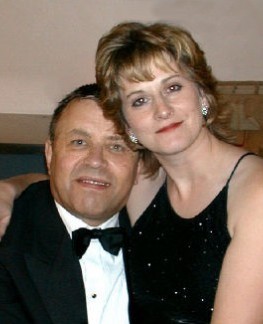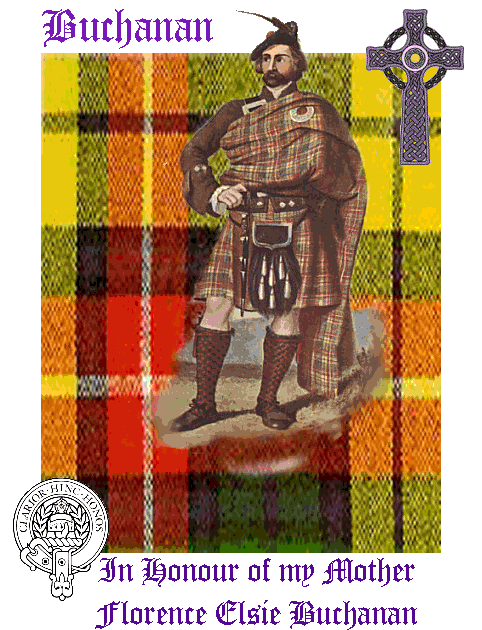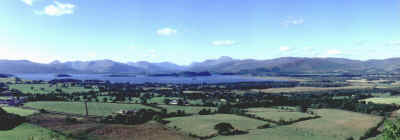

 |
 |

The name Buchanan is of territorial origin from the lands in Stirlingshire bordering Loch Lomond, originally known by the Gaelic name "Buth Chanain" meaning "Canon's House". Prior to the general adoption of the name, the clan was known as MacAuslane claiming descent from Anselan O'Kyan "son of Kayn" King of Ulster.

The Buchanan clan have the oldest established clan societiy in Scotland. The Clan's Heartland lies on a small island measuring a mere half a mile in length, of Clair Innis or Clarinch on Lock Lommond.
The Buchanans have ecclesiastical origins, and are hereditary clerics of the Celtic church. The Buchanan clan origniated in 1016 A.D. when Anselan O'Kyan (or Absalon) fled Ireland. He was the son of the reigning Ulster monarch and was forced to flee Ireland by Canute the Dane.
He was then employed by Malcom II (the Scottish king) to defend against Norse attacks in the west and was awarded land (through marriage into the family of the Earl of Lennox) on the east bank of Loch Lomond.
The first record of the name appears in 1224 when Dominus de Buchkan witnessed a charter by Malcolm, Earl of Lennox. King David II officially recognised the family of Buchquhanane in the 14th Century.
Clarinch is a small island, measuring just half a mile in length, named Clar Innis or Clarinch, on Loch Lomond. It is on this island that the clan was first recorded in 1225. That was when the island was given to Sir Anselan of Absalon of Buchanan, said to be a son of Macbeth. Buchanan Castle stands on that land today, although it was built and owned by the Montrose family. It is now surrounded by a golf course, Club Buchanan Castle. The clubhouse sits on the former grounds of Buchanan house which owns the clan's most precious possession, its heartland from which it gets its warcry.
In 1225 Macbeth the father of Gillebrid de Buchanan obtained from Maelduin, Earl of Lennox, a charter for the island of Clarinch near Balmaha which became the Clan's Battle Cry - Clarinch.
In 1282 Sir Maurice de Buchanan received from Donald, the sixth earl of Lennox, a charter for the lands of Buchanan. The Buchanan lands lying to the east of Loch Lomond, remained in the clan for nearly seven centuries. The lands and the Buchanan House were sold in 1682 to the 3rd Marquess of Montrose on the death of John, the 22nd laird. Despite the number of cadet branches, the clan became dispersed.
During the wars of succession (English Wars) Maurice, the chief of the Buchanan Clan had the distinction of being one of the few notables of Scotland that would not sign Edward I's 'Ragman Roll', or swear allegiance to Edward I of England and stood firmly for the independence of Scotland and the cause of Robert de Bruce (1306 to 1329).
Auchmar records a tradition that after the defeat at Dalrigh, Bruce was joyfully received in the Buchanan country by its chief, that the King's cave, near Inversnaid, takes its name from this episode, and that Buchanan with the Earl of Lennox afterwards conveyed the King to safety.
"In the 1420s, The Earls of Buchan, Douglas, Murray and Mar had led some 6,000 Scottish Knights and Men-at-Arms to France to help the King of France against the English. They were under the command of the Scottish Constable Sir John Stewart of Darnley and the Constable of the King of France’s Scottish Division Sir John de Montgomery, Laird of Giffen and Seigneur d’Azay-le-Rideau. They participated at the siege of Orleans alongside Rene d’Anjou and Joan of Arc., ref: Comte Hugh de Montgomery
During the battle of Agincourt the king of France requested support from Scotland of 7000 men. Sir Alexander Buchanan Earl of Buchanan and Constable of France went as the head of this army and at the battle of Beauge encountered the Duke of Clarence and slew him and carried off his corornet on his spear point. The King of France awarded him for his service to France the double tressure flory counterfiory, which forms part of the Buchanan arms to the present day and also for crest a hand holding a ducal cap. Sir Alexander Buchanan was later killed at the battle of Verneuil in 1424.
"In 1425 Charles VII of France created an elite bodyguard of Scots consisting of two sub-divisions: a) ‘Garde du Roi’ - b) ‘Garde de Corps du Roi’(4). However, there were still a great number of Scots gentlemen who could not be accommodated in the Scots guards, as these two divisions were collectively known, and this group formed themselves into what amounted to an independent mercenary company called ‘Compagnie des gentilhommes Ecossais’ and wore a Fleur de Lys on their left breast to show that they owed allegiance to the King of France. ref: Comte Hugh de Montgomery
Buchanan Castle and the ancestral burial grounds of the Buchanans and the Buchanan Arms is a hotel decorated throughout in Buchanan Tartan.
The George Buchanan monument is an eighteenth century monument erected to the memory of one of the Buchanan clan's most notable members. George Buchanan was born in 1506, one of the Drummakill Buchanans. He was a 16th century poet who schooled in Paris and was renowned throughout Europe as a Latin scholar. He was a tutor to Mary Queen of Scots and latter to her son, James VI of Scotland and I of England. His writings (in which he valued truth above political correctness) put him in trouble with the Church and the King and Queen. He died on 28th September 1582 and is esteemed as the last and greatest Latinists, and one of the first apostles of modern democracy.
The monument was built in 1788 with the foundation stone being laid by the Reverend James Graham, the parish minister in June, 1788. It is 103 feet high and is 19 feet square at the base. It is owned and maintained by the Buchanan Society, the world's oldest clan society.
Sir George Buchanan was the twenty-first Chief who commanded the Stirlingshire Regiment in the Civil Wars of Charles I and fought at the battle of Dunbar being taken prisoner at Inverkeithing.
Due to the failure of the direct line of Chiefship the clan took no part in the Jacobite rebellions of 1715 and 1745 which it is said was not unfortunate for the bearers of the name Buchanan.
The Buchanan Arms was an inn and farm when it was sold in 1860. The 4th Duke of Montrose purchased the property from the Buchanans of Drummakill. The Montrose family sold the property in 1931.
it is decorated throughout in Buchanan tartan. The decoration included Buchanan tartan carpeting. As the picture below shows, the carpeting in the upper hallway is still Buchanan tartan.
The isle from which the Buchanan clan warcry originated.
North of Glasgow, miles beyond the Pass of Leny, lies Loch Lubnaig ("the crooked lake"), divided into two reaches by a rock. Callander and nearby is Little Leny, the ancestral burial grounds of the Buchanans.
A small stone church was built on Inchcailloch in the late 12th or 13th century. It was Roman Catholic from the 13th century until the reformation and was used by the people of Inchcailloch until 1670.
In 1474 the Buchanans built St. Mary’s Chapel near Buchanan Auld House. After the reformation in the 16th century the Buchanans were considerable landowners and were responsible for the upkeep of both churches. The Buchanans refused to sanction repairs to the Inchcailloch church possibly hoping it would be abandoned. It was abandoned as a parish church in 1621. The 3rd Duke of Montrose had the Buchanan Parish Church built in 1764 to replace St. Mary’s Chapel. Stone from the original chapel was used in its construction and graves were moved to the new churchyard. The old chapel now lies in woodland.
A list of the castles held at one time by Buchanans appears below:
Arnprior Castle · Auchenreoch Castle · Auchleshie · Bardowie Castle · Boturich Castle · Buchanan Auld House · Carbeth House · Carrick House · Craigend Castle · Dunglass Castle · Leny House · Northbar · Ross Priory · Scotscraig
The Buchanans Levy lived at Leny Estate. The estate is now a bed and breakfast.
In 1790 Ross Priory was purchased by Sir William Buchanan whose family occupied it until 1925. It now belongs to a university.
Craigend castle and estate was owned by the Smiths, but was purchased by Sir Andrew Buchanan, ambassador to the Viennese Court. In the early 20th century it was tenanted by George Outram, newspaper proprietor, and Sir Harold Yarrow, the Clyde shipbuilder. The Buchanans sold Craigend to the Wilsons after World War II. The Buchanans of Carbeth held Carbeth estate and lived in Carbeth House. Arnprior Castle apparently no longer exists.
Buchanans still live in Bardowie Castle, which once belonged to the Hamiltons of Cardow. A Buchanan also owned Balloch Castle, which is now a park.